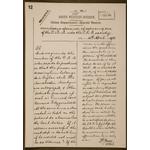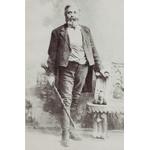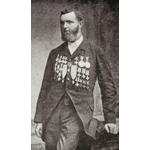Those that set the stage
Michael Cusack, Maurice Davin and the Gaelic Athletic Association
Although not formally involved in the 1916 Rising, the Gaelic Athletic Association contributed significantly by producing a generation of young men with a sense of national identity, an extreme nationalist ethos, and a hostility towards the government, state institutions, and the forces of law and order. Michael Cusack (1847-1906) was born at Carron near Corofin, Co Clare, the son of a herdsman. He qualified as a primary and secondary teacher.
Following some years in the United States, he taught in a school in Newry, Co. Down, Blackrock College, Co. Dublin and Clongowes Wood College, Co. Kildare. In 1877 he set up the Civil Service Academy which prepared students for civil service and other professional examinations. In his youth Cusack was a distinguished athlete and in Dublin he became involved in organising athletics. He established a hurling club as a feature of his Academy, and was involved in various attempts to revive the game in Dublin. Cusack was passionately interested in Gaelic culture and was active in the movement for the revival of the Irish language.
Like many other nationalists of the time, he regarded athletics and the games of hurling, football and handball as intrinsic features of traditional Irish culture; he believed that they should be used to promote a distinctive national identity. He was supported by two national newspapers, United Ireland and The Irishman, which published a number of his anonymous articles on the subject of traditional games and pastimes. Cusack’s interest in traditional games was shared by many, but especially by Maurice Davin (1841-1927), a farmer near Carrick-on-Suir, Co. Tipperary and a former athlete with an international reputation.
On 11 October 1884 United Ireland and The Irishman featured an article by Cusack, entitled ‘A Word About Irish Athletics’. Two weeks later Davin published a letter in the same papers expressing rather similar sentiments. On 1 November 1884 Cusack and Davin convened a meeting at Hayes’s Hotel in Thurles, Co. Tipperary, at which the Gaelic Association for the Preservation and Cultivation of Gaelic Games (later the Gaelic Athletic Association) was established with Davin as president and Cusack as secretary. As the GAA was an organisation with potentially a membership of some hundreds of thousands of fit young men of military age and represented throughout the country, the Fenians recognised its value as a recruitment pool.
As a result, Fenians infiltrated the organisation and managed to gain effective control within two years, ousting Cusack from the position of secretary. Clerical opposition to Fenian influence, however, resulted in a more discreet exploitation of the organisation by the Fenians: in the early decades of the twentieth century many of the leaders were members of the Irish Republican Brotherhood or in sympathy with its aims. While not overtly a revolutionary movement, the GAA was resolutely nationalistic, excluding members of the police or armed forces and people who played ‘imported games’.
Members of the GAA were prominent in the Irish Volunteers, hurleys commonly appearing in place of guns in drill and training exercises. Many members of the GAA took part in the 1916 Rising, but only in an individual capacity. As already said, the Association may be said to have indirectly made a significant contribution to the Rising. It produced a generation of physically fit and self-confident young men, many of whom it equipped with organisational skills of a high order.
It fostered an awareness of Irish identity and pride in being Irish, resulting in a more critical attitude towards Britain, its government and its agencies.





